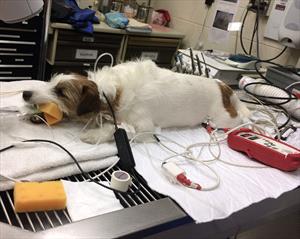Dog under anesthesia

Photo by Dr. Rachael Carpenter
Pet owners may shy away from surgical or dentistry procedures for their pets because they fear the risks of anesthesia. While it’s a good to consider the risks and benefits of general anesthesia for elective procedures, anesthesia is now safer than ever. If the proposed procedure will improve your pet’s quality of life, then fear of anesthesia shouldn’t prevent you from moving forward.
This was not always the case. In the 40s, 50s and 60s — well over half a century ago — death from anesthesia was about 1 in 400 for dogs and 1 in 260 for cats. These numbers are from referral hospitals, which are generally anesthetizing sicker patients, and that could increase the numbers over what you would expect to see in healthier pets in a general practice. There is a study from the early 2000s in the U.K. that followed mortality in a variety of practices (from general practices all the way to referral hospitals) and included dogs, cats, birds and pocket pets; in it, they found a death rate from 1 in 588 for dogs and 1 in 416 for cats. The risk has continued to drop, so that today those fatality numbers are around 1.7 in 1,000 dogs and 2.4 in 1,000 cats.
Although only statistics for dogs and cats have been created, the same improvement in risk applies to other pets such as rabbits, rats, hedgehogs, bearded dragons, and even goldfish as equipment and teaching new methods of anesthesia have improved over the years.
How does it work?
General anesthesia is given through an IV or an inhaled gas, or sometimes a combination of the two. It is similar, on a smaller scale, to a medically-induced coma. Oftentimes a sedative is given first.
It works by interrupting nerve signals in your pet's brain and body. It keeps them temporarily unconscious: asleep, relaxed, and pain free during a procedure or surgery. It slows down automatic functions like breathing, heart rate, and circulation. During that coma-like period, brains cannot process pain, nor will the pet remember what happened during surgery.
During the procedure, the veterinarian or veterinary anesthesiologist will check some basic functions while your pet is under, such as breathing, temperature, heart rate, blood pressure, blood oxygen level, and fluid levels (as would happen in a human surgery). Monitoring doesn’t have to be done with expensive equipment, as having a trained person monitoring the depth of anesthesia as well as certain physical parameters can be just as valuable. Computerized anesthesia monitors can be used to enhance, but not replace, that person’s ability.
If those functions aren't where the veterinarian wants them to be, adjustments in the level of anesthesia can correct them.
Monitoring doesn’t stop when surgery is over, or even when the equipment is removed. About half of the anesthesia deaths in small animals happen during the first 3 hours after surgery. The causes are usually breathing or heart problems. That makes this time critical for patient safety. Careful monitoring by a trained observer of physical variables, especially oxygenation and temperature, can help make this time period safer.
What main factors influence anesthetic risk?
Not unsurprisingly, the first is the health of the animal. Healthy patients, or patients with mild, controlled disease, are at less risk than patients who are sick. For healthy dogs, about 1 in 2,000 are expected to have a fatality and about 1 in 1000 cats would have one. In sicker patients, it would be closer to 13 dogs and 14 cats out of 1,000.
Having anesthesia in an emergency can also increase risk. That makes sense if you think about it. When you have time to plan a procedure, stabilize your patient and can schedule surgery at a time that is optimal for everyone, things go better. Having said that, the risk of anesthetic death with an emergency procedure, while higher than regular procedures, is still low. Emergencies are emergencies because they can’t wait, and there are times that the pet will die if surgery is not done as soon as possible, such as with bloat.
Veterinarians can decrease risk by focusing on monitoring and supportive care before, during, and after anesthesia. Preoperative planning is done with a good history, physical examination, and often baseline lab work to check liver and kidney function, among other things. Any abnormalities identified before surgery can be corrected if needed.
Follow all of your veterinarian’s pre-operative instructions exactly, including when to stop giving food the night before. Anesthetized patients lose their ability to swallow. If there is food in the stomach, the pet could vomit while under anesthesia or soon afterwards. If vomiting occurs before the swallowing reflex comes back, the vomited material can enter into the lungs, causing aspiration pneumonia. For emergency surgery, this factor is overlooked, but not for elective surgery.
While anesthetic risk is not zero and never will be, the risks are low and shouldn’t prevent any pet owner from providing health care for their pet whether it’s a dental cleaning or major surgery.